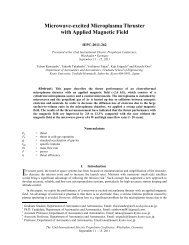Development of a Magnesium and Zinc Hall-effect Thruster
Development of a Magnesium and Zinc Hall-effect Thruster
Development of a Magnesium and Zinc Hall-effect Thruster
You also want an ePaper? Increase the reach of your titles
YUMPU automatically turns print PDFs into web optimized ePapers that Google loves.
was performed the anode voltage increased from about 100 to 300 V, as shown in Fig. 12. It is reasonable to assume<br />
that increasing anode voltage at constant current corresponds to decreasing propellant mass flow.<br />
Fig. 12. <strong>Zinc</strong> thruster data while operating using a consumable anode.<br />
The same four-grid RPA used for the magnesium experiments was placed 1 m downstream <strong>of</strong> the thruster on<br />
the thruster axis. RPA data were acquired at a few <strong>of</strong> the operating conditions while the thruster was running<strong>and</strong><br />
areshown in Fig. 13, Fig. 14, <strong>and</strong> Fig. 15. Just as with the magnesium thruster, the RPA data from the zinc thruster<br />
shows reasonable acceleration <strong>of</strong> the propellant ions.<br />
Fig. 13. Retarding potential analyzer I-V sweep <strong>and</strong> derivative <strong>of</strong><br />
probe current with respect to repeller voltage with 180 V <strong>and</strong> 3 A on<br />
the anode <strong>and</strong> 4.5 A <strong>of</strong> magnet current during zinc operation.<br />
The 31 st 10<br />
International Electric Propulsion Conference, University <strong>of</strong> Michigan, USA<br />
September 20 – 24, 2009






